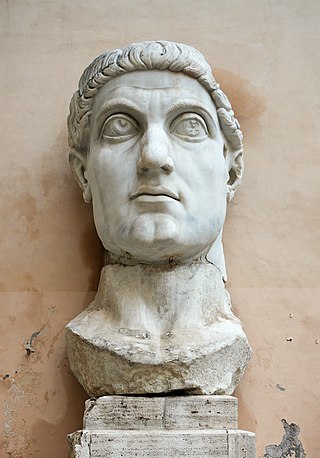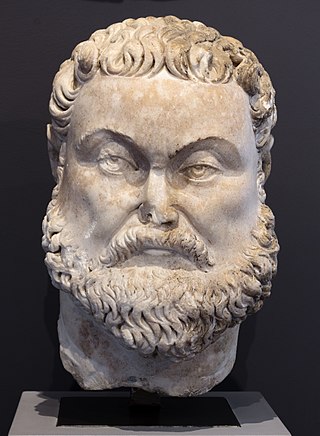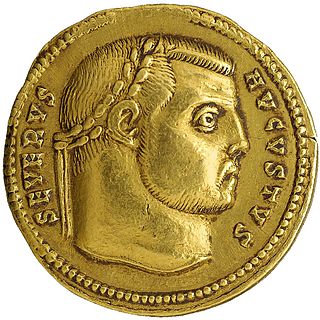Related Research Articles

Constantine I, also known as Constantine the Great, was a Roman emperor from AD 306 to 337 and the first Roman emperor to convert to Christianity. He played a pivotal role in elevating the status of Christianity in Rome, decriminalizing Christian practice and ceasing Christian persecution in a period referred to as the Constantinian shift. This initiated the cessation of the established ancient Roman religion. Constantine is also the originator of the religiopolitical ideology known as Constantinianism, which epitomizes the unity of church and state, as opposed to separation of church and state. He founded the city of Constantinople and made it the capital of the Empire, which remained so for over a millennium.
The 310s decade ran from January 1, 310, to December 31, 319.

Year 312 (CCCXII) was a leap year starting on Tuesday of the Julian calendar. In the Roman Empire, it was known as the Year of the Consulship of Constantinus and Licinianus. The denomination 312 for this year has been used since the early medieval period, when the Anno Domini calendar era became the prevalent method in Europe for naming years.

The Battle of the Milvian Bridge took place between the Roman Emperors Constantine I and Maxentius on 28 October 312 AD. It takes its name from the Milvian Bridge, an important route over the Tiber. Constantine won the battle and started on the path that led him to end the Tetrarchy and become the sole ruler of the Roman Empire. Maxentius drowned in the Tiber during the battle; his body was later taken from the river and decapitated, and his head was paraded through the streets of Rome on the day following the battle before being taken to Africa.

Galerius Valerius Maximianus was Roman emperor from 305 to 311. During his reign he campaigned, aided by Diocletian, against the Sasanian Empire, sacking their capital Ctesiphon in 299. He also campaigned across the Danube against the Carpi, defeating them in 297 and 300. Although he was a staunch opponent of Christianity, Galerius ended the Diocletianic Persecution when he issued the Edict of Toleration in Serdica (Sofia) in 311.

Maximian, nicknamed Herculius, was Roman emperor from 286 to 305. He was Caesar from 285 to 286, then Augustus from 286 to 305. He shared the latter title with his co-emperor and superior, Diocletian, whose political brain complemented Maximian's military brawn. Maximian established his residence at Trier but spent most of his time on campaign. In late 285, he suppressed rebels in Gaul known as the Bagaudae. From 285 to 288, he fought against Germanic tribes along the Rhine frontier. Together with Diocletian, he launched a scorched earth campaign deep into Alamannic territory in 288, refortifying the frontier.

Marcus Aurelius Valerius Maxentius was a Roman emperor from 306 until his death in 312. Despite ruling in Italy and North Africa, and having the recognition of the Senate in Rome, he was not recognized as a legitimate emperor by his fellow emperors.

Flavius Valerius Severus, also called Severus II, was a Roman emperor from 306 to 307, and a member of the Tetrarchy. He shared control of the western half of the empire with Constantine I, but spent most of his short reign in a civil war against the usurper Maxentius, who later killed him and took over Italy.

The Arch of Constantine is a triumphal arch in Rome dedicated to the emperor Constantine the Great. The arch was commissioned by the Roman Senate to commemorate Constantine's victory over Maxentius at the Battle of Milvian Bridge in AD 312. Situated between the Colosseum and the Palatine Hill, the arch spans the Via Triumphalis, the route taken by victorious military leaders when they entered the city in a triumphal procession. Dedicated in 315, it is the largest Roman triumphal arch, with overall dimensions of 21 m (69 ft) high, 25.9 m (85 ft) wide and 7.4 m (24 ft) deep. It has three bays, the central one being 11.5 m (38 ft) high and 6.5 m (21 ft) wide and the laterals 7.4 m (24 ft) by 3.4 m (11 ft) each. The arch is constructed of brick-faced concrete covered in marble.

Eutropia was a Roman empress of Syrian origin, the wife of Emperor Maximian.

The Battle of Turin was fought in 312 between Roman emperor Constantine the Great and the troops of his rival Maxentius. Constantine won the battle, showing an early example of the tactical skill which was to characterise his later military career. The campaign ended with his more famous victory at the Milvian Bridge immediately outside of Rome.

The Battle of Verona was fought in 312 between the forces of the Roman emperors Constantine I and Maxentius. Maxentius' forces were defeated, and Ruricius Pompeianus, the most senior Maxentian commander, was killed in the fighting.

The civil wars of the Tetrarchy were a series of conflicts between the co-emperors of the Roman Empire, starting from 306 AD with the usurpation of Maxentius and the defeat of Severus to the defeat of Licinius at the hands of Constantine I in 324 AD.
Pompeius Probus was a politician of the Roman Empire during the Tetrarchy, active at the Eastern court under Emperors Galerius and Licinius.

The Religious policies of Constantine the Great have been called "ambiguous and elusive." Born in 273 during the Crisis of the Third Century, Constantine the Great was thirty at the time of the Great Persecution. He saw his father become Augustus of the West and then shortly die. Constantine spent his life in the military warring with much of his extended family, and converted to Christianity sometime around 40 years of age. His religious policies, formed from these experiences, comprised increasing toleration of Christianity, limited regulations against Roman polytheism with toleration, participation in resolving religious disputes such as schism with the Donatists, and the calling of councils including the Council of Nicaea concerning Arianism. John Kaye characterizes the conversion of Constantine, and the Council of Nicea that Constantine called, as two of the most important things to ever happen to the Christian church.
Gaius Annius Anullinus was a Roman senator who was appointed consul in AD 295.
Gaius Vettius Cossinius Rufinus was a politician and senator of the late Roman Empire.

The Conference of Carnuntum was a military conference held on 11 November 308 in the city of Carnuntum, which at the time was located in the Roman province of Pannonia Prima. It was convened by the Eastern augustus (emperor) Galerius as a way to settle the dispute over the title of augustus in the West, and consequently, to cease the ongoing conflicts started the previous year when he, and before that Severus II, attempted to recover Italy from the usurpers Maxentius and Maximian. Present at the conference were the retired Diocletian, and his former colleague, Maximian.

The Battle of Brescia was a confrontation that took place during the summer of 312, between the Roman emperors Constantine the Great and Maxentius in the town of Brescia, in northern Italy. Maxentius declared war on Constantine on the grounds that he wanted to avenge the death of his father Maximian, who had committed suicide after being defeated by him. Constantine would respond with a massive invasion of Italy.

The siege of Segusio or siege of Susa was the first clash of the civil war between the Roman emperors Constantine the Great and Maxentius in the spring of 312. In that year, Maxentius had declared war on Constantine, claiming to intend to avenge the death of his father Maximian, who had committed suicide after being defeated by him. Constantine would respond with an invasion of northern Italy.
References
- 1 2 Jones, A.H.M.; J. R. Martindale; J. Morris (1971). The Prosopography of the Later Roman Empire, vol. 1. Cambridge: Cambridge University Press. p. 713. ISBN 978-0-521-07233-5.
- ↑ Gibbon, Edward. The Decline And Fall Of The Roman Empire . Retrieved 2008-07-21.
{{cite book}}:|work=ignored (help)
- Barnes, Timothy D. Constantine and Eusebius. Cambridge, MA: Harvard University Press, 1981. (p. 42) ISBN 978-0-674-16531-1
- Jones, A. H. M. Constantine and the Conversion of Europe. Buffalo: University of Toronto Press, 1978 [1948]. (p. 71)
- Odahl, Charles Matson. Constantine and the Christian Empire. New York: Routledge, 2004. (pp. 103–4) Hardcover ISBN 0-415-17485-6 Paperback ISBN 0-415-38655-1